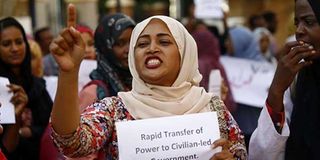Sudan’s five months of anti-government protests

A Sudanese health worker carries a placard during protests in the capital Khartoum on May 23, 2019. PHOTO | ASHRAF SHAZLY | AFP
What you need to know:
- Protests erupted in various cities on December 19, 2018 against a government decision to triple bread prices.
- President Bashir declared a nationwide state of emergency on February 22, 2019.
- On June 3, a doctors' committee close to the demonstrators says at least five protesters are killed and many wounded.
Khartoum
The sit-in protest outside Sudan's army headquarters in Khartoum that authorities used deadly force to try to disperse Monday began in April and stayed put even after president Omar al-Bashir's ouster.
The thousands of demonstrators at the camp are demanding civilian rule in the tightly controlled and impoverished country, in a popular uprising that first began in December.
Here is a timeline:
December 19, 2018: Protests erupt in various cities against a government decision to triple bread prices. They spread and morph into calls for Bashir to quit after three decades of iron-fisted rule.
December 20: The protests reach Khartoum with demonstrators chanting "freedom, peace, justice".
Clashes break out as police try to disperse the crowds. Eight demonstrators are killed in two cities, the first of dozens of deaths in protest-related violence over the following months.
STATE OF EMERGENCY
February 22, 2019: Bashir declares a nationwide state of emergency. He swears in a new prime minister two days later, as riot police confront hundreds of protesters calling for him to resign.
April 6: Thousands gather for the first time outside military headquarters in Khartoum, chanting "one army, one people" in a plea for the military's support.
They defy attempts by police to dislodge them with tear gas and gunshots fired into the air.
April 11: Authorities announce Bashir has been removed from power and that a transitional military council will govern for two years. Elation turns to anger as protesters denounce a "military coup" that leaves the regime in place, thousands remaining camped outside army headquarters.
April 14: Protest leaders demand that the new military rulers transfer power to a civilian government.
April 20: Sudan's military rulers hold a first round of talks with protest leaders.
BREAKTHROUGH
April 27: Breakthrough as the two sides agree to establish a joint civilian-military ruling council. However, differences remain over the composition of the council, with each side demanding a majority.
April 30: Tensions flare as the military says six security force members are killed in protests. Demonstrators reinforce their sit-in outside the army HQ.
May 2: Demonstrators gather in the capital as protest leaders say the army is not serious about handing over power.
May 15: Amid expectations that agreement will be reached on a three-year transition to a civilian administration, military leaders suspend talks, insisting demonstrators remove barricades they have set up in the capital.
TALKS RESUME
May 19: The talks resume but break down the following day, deadlocked over who should head the new governing body with the Alliance for Freedom and Change, the umbrella group of the protest movement, demanding the post goes to a civilian.
May 28: Thousands of workers in government offices, banks, private sector firms and the docks begin a two-day strike to pressure the military rulers.
Two days later, hundreds of women march to the military headquarters calling for a civilian government, followed by a protest by thousands more people the next day.
June 3: As tension builds around the army protest site, the military council uses force to disperse the thousands camped there.
There is a heavy security deployment and gunfire is heard around the city.
A doctors' committee close to the demonstrators says at least nine protesters are killed and many wounded.





